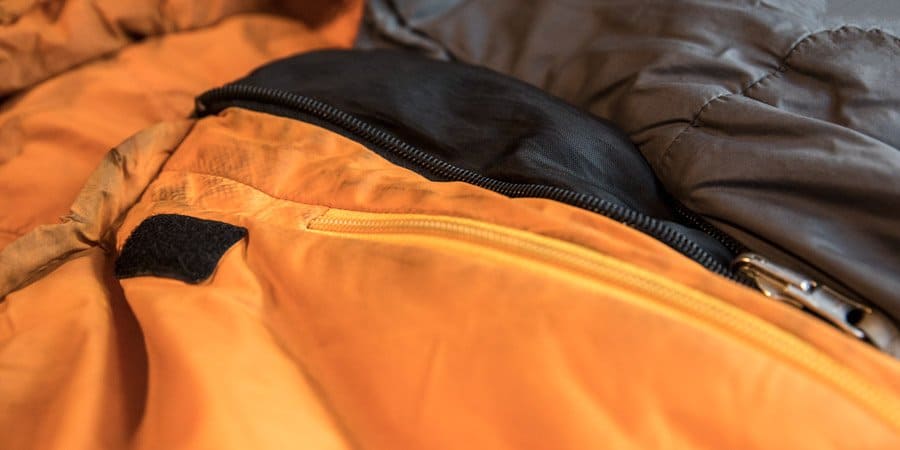Whether you spend a ton of time outside on amazing adventures or challenging hikes, or you simply like to escape for the weekend to a peaceful campsite, your sleeping bag is the one piece of gear that provides protection, comfort and warmth once you’re ready to turn in for the night.
The better maintained your sleeping bag is, the longer it will last and the more insulation it’ll retain. With these maintenance and cleaningtips, you can continue depending on your beloved sleeping bag for years to come. In this article, we’ll talk about basic sleeping bag care and maintenance tips, including how to wash and dry a sleeping bag, and we’ll also go over best practices for caring for your sleeping bag during and after a trip.

Table of Contents
Use a Sleeping Bag Liner
The best way to keep your sleeping bag clean, limiting the number of times you have to wash it, is to use a sleeping bag liner. You can find liners in all sorts of fabrics, including cotton, polyester, silk and wool. The liner forms a barrier between you and your bag, which will help to keep it clean.
Liners, while they can be lightweight, can also add some warmth to your sleeping bag, which is helpful if it’s cold out. You can wash your sleeping bag liner after each trip, cutting down on the times you have to wash your entire sleeping bag.
Washing and Drying a Sleeping Bag
The way you wash and dry a sleeping bag will depend on what the bag is made of – down or synthetic material. Down will require more time and attention, and you may want to have it professionally cleaned to avoid causing any damage to the bag.
The more you wash your sleeping bag, the more wear and tear you’re subjecting it to, which can decrease how comfortable, soft, and insulated it is. It’s always a good idea to keep it as clean as possible and only fully wash it when absolutely necessary. Unless it’s very dirty or the entire bag smells, you may be able to go several months or even years without giving it a complete wash. If you use your sleeping bag on a regular basis, aim for a full wash once a year.
The bag should have instructions from the manufacturer about how to properly wash and dry it. If you can’t find the instructions on the bag itself, try to look them up online. You can also call the manufacturer and ask if they have a company they partner with for professional laundering.

Spot Cleaning
Before you go for an all-out wash and dry, consider spot cleaning your bag. The hood and collar of your sleeping bag may be the only area that needs a good cleaning since this is where oils from your hair and skin accumulate the most.
Create a paste using non-detergent soap and water, then gently scrub the shell using a toothbrush. Rinse the area using a clean, wet sponge. When cleaning, pull the fabric away from the insulation so that you don’t get the fill wet.
Full Wash and Dry
You know you can’t get away with just a spot clean this time. Your bag is flattened from oils and other stains, and it’s darker all over than it should be. It’s time for a real wash. (Also, if you’ve noticed that the insulation is no longer evenly distributed, a wash and dry can help.)
If you’re going to wash and dry on your own, give yourself enough time. Drying a bag can take up to three hours; longer if it’s down. Since sleeping bags are large, head to a laundromat, where they’ll have big washers and dryers to use.
Follow these instructions for washing and drying your sleeping bag:
- To prevent damaging the fill or the fabric, loosen draw cords and fasten hook-and-loop closures.
- Choose a washer and dryer with plenty of extra room so your sleeping bag can get thoroughly clean.
- Wash your sleeping bag with a gentle, non-detergent soap that’s specifically made for washing your type of fabric. Don’t use too much – you don’t want the water to get too sudsy.
- Choose the gentle warm or cold cycle.
- To make sure that all of the soap is gone, either rinse it a second time or put it through another wash-rinse cycle, but without soap.
- Squeeze out excess water and transport the sleeping bag from the washer to the dryer in a loose ball.
- Carrying it in this way will limit the stress put on the seams.
- Put the dryer on low heat and check your sleeping bag often to make sure it’s not getting too hot, which can cause the fill to melt.
- If the sleeping bag is down, add three clean tennis balls when it’s about dry. This will break up clumps of insulation as it dries, which will help the sleeping bag to maintain its loft.
Before you store your sleeping bag, make sure it’s completely dry. You may want to keep it laid out at home overnight to be sure.

Washing by Hand
If you prefer to wash your sleeping bag by hand, follow these instructions:
- Fill your bathtub with either cool or warm water.
- Add a gentle, non-detergent soap for the type of fabric your sleeping bag is made of. Don’t use too much soap – very sudsy soap is hard to rinse out completely.
- Lay the bag in the water, then gently work the soapy water through the bag. For heavily soiled areas, you can rub the fabric together to loosen up the dirt.
- Let the bag soak for one hour.
- Drain the tub.
- Press out any remaining water from the sleeping bag.
- Fill the tub again with cool or warm water.
- Rinse the sleeping bag by working the soap out of it.
- Let the sleeping bag soak for 15 minutes, then drain the tub and press out the remaining water. You’ll want to repeat this process as many times as it takes to remove all the soap.
- Once the soap is gone, gently squeeze excess water from the bag.
- Slide your arms underneath the bag, gather it into a ball and transport it to the dryer.
- If you want the bag to air dry, lay it on a clean, flat surface outside, like a large beach towel. It’s best if the bag is in a shady area instead of direct sunlight.
- As the bag dries, it’s normal to have to break up clumpy insulation with your hands.
Whatever You Do, Don’t…
- Have your sleeping bag dry cleaned. The solvents that dry cleaners use will strip the natural oils from the sleeping bag and make it lose its loft.
- Use bleach, bleach alternatives or fabric softener.
- Wash a sleeping bag in a top-loading machine that has an agitator. This is another reason to use a laundromat, where they’ll have front-loading machines. The agitator can cause the seams to rip or become strained. Note that it’s okay to use a top-loading machine if it doesn’t have an agitator.

Caring for Your Bag When You’re Still at Camp
As you’re camping, try to keep your sleeping bag as clean, dry and shielded from the elements as possible – this goes whether your sleeping bag is down or synthetic. Here are a few ways to keep your bag as clean as possible while camping.
Transport your sleeping bag in a compression and/or waterproof stuff sack. That way, it won’t pick up any dirt or debris, or get stained, along the way. Throwing it in your trunk is a good way to get your sleeping bag dirty before your trip has even begun.
Insider tip: It can be pretty frustrating to get your sleeping bag inside a stuff sack. While I had to watch a YouTube video or two to figure it out for myself, the best piece of advice is to get as much air out of it as possible before and during the stuffing.
Put a pad on the ground and put your sleeping bag on top of it. This is especially important if you’re going to be sleeping directly on the ground instead of in a tent. Even durable fabrics can use extra protection from sticks and other sharp objects on the ground.
Change into clean clothes before you go to sleep. Yes, we know you’re completely wiped out and all you can think about is finally getting some shut-eye, but don’t go to sleepin the same clothing you’ve been playing in all day, or even clothing you cooked in, which can attract bears. Body oils, dirt and sweat can strip your sleeping bag of its insulation. Wear as much clothing as you can to cover your body without getting overheated, and sleep with a bandana or beanie on your head to keep the oils from your scalp off the sleeping bag.

Wipe yourself down before going to sleep. If you have lotion or sunblock on your body or face, you’ll want to wipe it off before laying down on your sleeping bag. Lotions and oils can seep into the sleeping bag.
Air your sleeping bag out every day, turning it inside out first. The cleaner you can keep your bag, the less often you’ll have to wash it. By airing it out after a night of sleep, you’ll get rid of any lingering moisture – left unattended, moisture can make the bag smell or create mildew. Note that you don’t want to expose your bag to direct sunlight for too long, since UV light can degrade the fabric.
Don’t wear the bag around too much. It’s tempting to wrap your sleeping bag around you as you walk around camp if there’s a chill in the air or as you hang out by the fire, but this can speed up the wear-and-tear process. If you want a sleeping bag that you can beat up a little bit, pack a second one specifically for that purpose.
Caring for Your Sleeping Bag After Your Trip
As soon as you get home from your trip, remove the sleeping bag from the stuff sack and leave it somewhere where it can dry out completely. Then, store it loosely – not crammed into the stuff sack again – in cotton or mesh storage sack, which you may have received when you bought the sleeping bag.
You can also use a large pillowcase to store the sleeping bag. Basically, you want to use something that will keep it clean and protected without compressing it too much. If you keep it compressed, it will damage the fill. Also, a watertight storage bag can cause condensation to build up, which can cause mildew.

The All-Outdoors Guide team is comprised of enthusiastic experts that enjoy helping others that aspire to be better at outdoor fun. Part of that is making sure you have the right gear and information when it’s time to go out and have fun. Some of our team have accomplished amazing feats like climbing 6000 feet to the top of mountains, others have explored every dirt trail they could find and we even have some people that have backpacked solo on various continents. No matter what our readers want to learn and do, our team is here to help them accomplish those goals.

